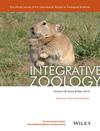山地瞪羚(Gazella gazella)的雄瞪羚会在有利的地点相互使用粪堆。
IF 3.5
1区 生物学
Q1 ZOOLOGY
引用次数: 0
摘要
雄性山地羚羊会将粪便堆(不同颜色和形状的粪便堆代表不同单倍型的粪便堆)堆放在偏好的林地中,并在领地边界上标记相同的粪便堆(双色圆圈)。本文章由计算机程序翻译,如有差异,请以英文原文为准。

Mountain gazelles’ (Gazella gazella) males use mutual dung middens in favorable locations
Males of the mountain gazelle deposit dung middens (different colors and shapes represent middens of different haplotypes) in preferable forest plots and countermark the same middens (two color circles) at the boundaries of their territories.
求助全文
通过发布文献求助,成功后即可免费获取论文全文。
去求助
来源期刊

Integrative zoology
ZOOLOGY-
CiteScore
6.40
自引率
12.10%
发文量
81
审稿时长
>12 weeks
期刊介绍:
The official journal of the International Society of Zoological Sciences focuses on zoology as an integrative discipline encompassing all aspects of animal life. It presents a broader perspective of many levels of zoological inquiry, both spatial and temporal, and encourages cooperation between zoology and other disciplines including, but not limited to, physics, computer science, social science, ethics, teaching, paleontology, molecular biology, physiology, behavior, ecology and the built environment. It also looks at the animal-human interaction through exploring animal-plant interactions, microbe/pathogen effects and global changes on the environment and human society.
Integrative topics of greatest interest to INZ include:
(1) Animals & climate change
(2) Animals & pollution
(3) Animals & infectious diseases
(4) Animals & biological invasions
(5) Animal-plant interactions
(6) Zoogeography & paleontology
(7) Neurons, genes & behavior
(8) Molecular ecology & evolution
(9) Physiological adaptations
 求助内容:
求助内容: 应助结果提醒方式:
应助结果提醒方式:


